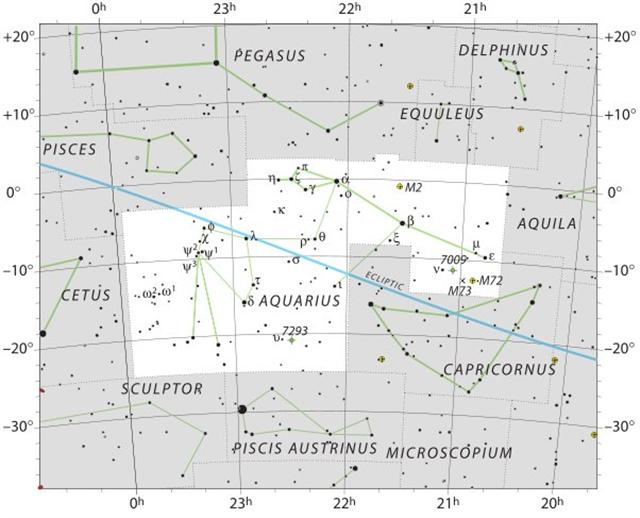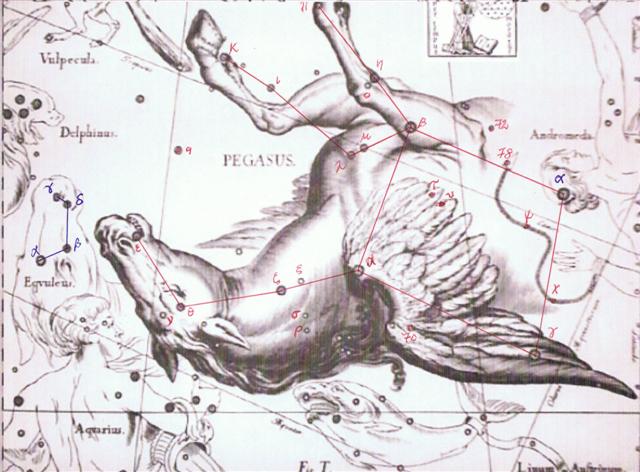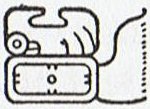421. The Roman day Terminalia was
followed by Bissextum:
... The leap day was introduced as
part of the Julian reform. The day following the
Terminalia (February 23) was doubled, forming the 'bis
sextum - literally 'double sixth', since
February 24 was 'the sixth day before the Kalends of
March' using Roman inclusive counting (March 1 was
the 'first day'). Although exceptions exist, the
first day of the bis sextum (February 24) was
usually regarded as the intercalated or 'bissextile'
day since the third century. February 29 came to be
regarded as the leap day when the Roman system of
numbering days was replaced by sequential numbering
in the late Middle Ages ...
|
DEC 18
(336 +
16) |
19
(*273) |
20 (354
=
☼270) |
SOLSTICE |
 |
 |
 |
 |
|
Gb2-17
(272 = 2
* 136) |
Gb2-18 |
Gb2-19
(45 =
360 / 8) |
Gb2-20
(275) |
|
ζ Cephei
(336.2),
λ Cephei
(336.3),
-/270
Lac.
(336.7),
λ Piscis
Austrini
(336.8) |
μ Gruis
(337.0),
ε Cephei
(337.2),
1/325
Lac.
(337.3),
ANCHA
(Hip) =
θ
Aquarii
(337.4),
ψ Oct.
(337.5),
α
Tucanae
(337.9)
*296 = *337.4 -
*41.4 |
Al Sa'ad
al
Ahbiyah-23
(Lucky
Star of
Hidden
Things)
/
Shatabisha-25
(Comprising
a
Hundred
Physicians)
ε
Oct.
(338.1),
ρ
Aquarii
(338.2),
2/365
Lac.
(338.5),
SADACHBIA
=
γ
Aquarii
(338.6),
π
Gruis
(338.9) |
β/172
Lac.
(339.2),
4/1100
Lac.
(339.4),
π
Aquarii
(339.5)
*298= *339.4 -
*41.4
CASTOR
(α
Gemini) |
|
Febr 20
(*336) |
21 (52) |
22 (418) |
Terminalia |
|
'Jan 24 |
25 (= 52
- 27) |
26 |
27 (392
= 365 +
27) |
|
"Jan 9
(*295 =
*336 -
*41) |
10 |
11 (377
= 418 -
41) |
12 (378
→
Saturn) |
|
...
Al Sa'd
al
Ahbiyah,
which
has been
interpreted
the
Lucky
Star of
Hidden
Things
or
Hiding-places,
because
when it
emerged
from the
sun's
rays all
hidden
worms
and
reptiles,
buried
during
the
preceding
cold,
creep
out of
their
holes!
But as
this
word
Ah Biyah
is
merely
the
plural
of
Hibā',
a Tent,
a more
reasonable
explanation
is that
the star
was so
called
from its
rising
in the
spring
twilight,
when,
after
the
winter's
want and
suffering,
the
nomads'
tents
were
raised
on the
freshening
pastures,
and the
pleasent
weather
set in.
This
idea
renders
Professor
Whitney's
'Felicity
of
Tents' a
happy
translation
of the
original.
ζ,
η,
and
π
are
included
with
γ
under
this
designation
by Ulug
Beg -
ζ,
in the
centre
marking
the top
of the
tent;
Kazwini,
however,
considering
this
central
star as
Al
Sa'd,
and the
three
surrounding
ones his
tents
...
 |
| DEC 22 |
23 (*277) |
CHRISTMAS EVE |
25 (☼275) |
26 (360) |
27 |
 |
 |
 |
 |
 |
 |
| Gb2-21 |
Gb2-22 |
Gb2-23 |
Gb2-24 (50) |
Gb2-25 (280) |
Gb2-26 |
| δ Tucanae (340.1), ρ Cephei (340.2), ν Gruis (340.3), AL SA'D = ζ Aquarii, δ Gruis (340.4), 5/1100 Lac. (340.7), σ Aquarii, 6/650 Lac. (340.9)
*299 = *340.4 -
*41.4
PROCYON (α Canis Minoris)
|
υ Oct. (341.0), α/91 Lac. (341.1), HOMAN (Hero) = ζ Pegasi, β Piscis Austrini (341.2), ν Tucanae (341.5), υ Aquarii (341.9) |
η Aquarii (342.1), σ Gruis (340.4), SITULA (Water-jar) = κ Aquarii (342.7)
*301 = *342.4 -
*41.4 |
ε Piscis Austrini (343.5), ο Pegasi, β Gruis (343.8) |
ρ Gruis (344.0), MATAR (Rain) = η Pegasi (344.2), η Gruis (344.6), β Oct. (344.7) |
λ Pegasi (345.0), ξ Pegasi (345.1), ε Gruis (345.3), τ Aquarii (345.7), ξ Oct. (345.8), μ Pegasi (345.9) |
| Bissextum |
Febr 25 (*341) |
26 |
27 (58) |
28 (424) |
March 1 (*345) |
| 'Jan 28 (393) |
29 (*314) |
30 |
31 |
'Febr 1 |
2 (33 = 398 - 365) |
| "Jan 13 |
14 (*300) |
15 |
16 |
17 (383 = 424 - 41) |
18 (☼300) |
|
... That the Sun-gods Dionysus, Apollo and Mithras were all also reputedly born at the Winter solstice is well known, and the Christian Church first fixed the Nativity feast of Jesus Christ at the same season, in the year AD 273 [= 3 * 91]. St. Chrysostom, a century later, said that the intention was that 'while the heathen were busied with their profane rites the Christians might perform their holy ones without disturbance', but justified the date as suitable for one who was 'the Sun of Righteousness' ... |
This was where, at the time of rongorongo, Procyon culminated (at 21h). Pollux (*116.2) - the immortal son of Zeus - ought to have culminated 3 days after his brother the Beaver (Castor, *113.4). At the time of Bharani the heliacal day of Castor had been *113.4 - *41.4 = *72.0 (= 360 / 5) = ☼68 (= 152 - 84) = "June 1 (152). The picture in Gb2-21 seems to illustrate a pair (bis) of eyes.
At the time of the Bull the flow from the Urn of Aquarius would have emerged in DECEMBER 24 (CHRISTMAS EVE) and this ought then to have been where Pollux culminated (at 21h):


This 'fresh water river' went down from the Urn to the mouth of Piscis Austrinus (the Southern Fish), to Fom-al-Haut (Mouth of the Fish), which presumably was illustrated in Gb2-28:
| DEC 28 |
29 |
30 (364) |
31 (*285) |
JAN 1 (366) |
 |
 |
 |
 |
 |
| Gb2-27 → π |
Gb2-28 (54) |
Gb2-29 → 229 |
Gb2-30 (285) |
Gb2-31 |
| ι Cephei (346.0), λ Aquarii, γ Piscis Austrini, σ Pegasi (346.5) |
SCHEAT AQUARII = δ Aquarii (347.0), ρ Pegasi (347.2), δ Piscis Austrini (347.4), FOMALHAUT (Mouth of the Fish( = α Piscis Austrini, τ Gruis (347.8) *306 = *347.4 - *41.4 |
FUM AL SAMAKAH (Mouth of the Fish) = β Piscium (348.3), ζ Gruis (348.5), ο Andromedae (348.9) |
Al Fargh al Mukdim-24 (Fore Spout) / Purva Bhādrapadā-26 (First of the Blessed Feet) / House-13 (Pig)
SCHEAT PEGASI = β Pegasi, π Piscis Austrini (349.3), κ Gruis (349.4), MARKAB PEGASI = α Pegasi (349.5)
*308 = *349.4 - *41.4 |
23h (350.0) υ, θ Gruis (350.0), π Cephei (350.6), ι Gruis (350.9) |
| March 2 |
3 |
4 (*348) |
5 (64) |
6 (430) |
| 'Febr 3 |
4 |
5 (36) |
6 (*322) |
7 (403) |
| "Jan 20 |
21 |
22 |
23 (388) |
24 (*309) |
 |
From 'February 24 (Bissextum) up to and including 'March 1 (60) there were 6 days. Possibly these 6 days corresponded to the distance from day 354 (12 * 29½) to day 360 (24 * 15) and possibly the Pope Gregory XIII had calculated with them, when arranging °March 1 (60) to be at the beginning of the Pegasus Square:
 |
 |
 |
 |
 |
 |
| Gb2-21 |
Gb2-22 |
Gb2-23 |
Gb2-24 (50) |
Gb2-25 (280) |
Gb2-26 |
| δ Tucanae (340.1), ρ Cephei (340.2), ν Gruis (340.3), AL SA'D = ζ Aquarii, δ Gruis (340.4), 5/1100 Lac. (340.7), σ Aquarii, 6/650 Lac. (340.9)
*299 = *340.4 -
*41.4
PROCYON (α Canis Minoris)
|
υ Oct. (341.0), α/91 Lac. (341.1), HOMAN (Hero) = ζ Pegasi, β Piscis Austrini (341.2), ν Tucanae (341.5), υ Aquarii (341.9) |
η Aquarii (342.1), σ Gruis (340.4), SITULA (Water-jar) = κ Aquarii (342.7)
*301 = *342.4 -
*41.4 |
ε Piscis Austrini (343.5), ο Pegasi, β Gruis (343.8) |
ρ Gruis (344.0), MATAR (Rain) = η Pegasi (344.2), η Gruis (344.6), β Oct. (344.7) |
λ Pegasi (345.0), ξ Pegasi (345.1), ε Gruis (345.3), τ Aquarii (345.7), ξ Oct. (345.8), μ Pegasi (345.9) |
| Bissextum |
Febr 25 (*341) |
26 |
27 (58) |
28 (424) |
March 1 (*345) |
| °Febr 20 |
21 (52) |
22 |
Terminalia |
Bissextum |
25 |
 |
 |
 |
 |
 |
| Gb2-27 → π |
Gb2-28 (54) |
Gb2-29 → 229 |
Gb2-30 (285) |
Gb2-31 |
| ι Cephei (346.0), λ Aquarii, γ Piscis Austrini, σ Pegasi (346.5) |
SCHEAT AQUARII = δ Aquarii (347.0), ρ Pegasi (347.2), δ Piscis Austrini (347.4), FOMALHAUT (Mouth of the Fish( = α Piscis Austrini, τ Gruis (347.8) *306 = *347.4 - *41.4 |
FUM AL SAMAKAH (Mouth of the Fish) = β Piscium (348.3), ζ Gruis (348.5), ο Andromedae (348.9) |
Al Fargh al Mukdim-24 (Fore Spout) / Purva Bhādrapadā-26 (First of the Blessed Feet) / House-13 (Pig)
SCHEAT PEGASI = β Pegasi, π Piscis Austrini (349.3), κ Gruis (349.4), MARKAB PEGASI = α Pegasi (349.5)
*308 = *349.4 - *41.4 |
23h (350.0) υ, θ Gruis (350.0), π Cephei (350.6), ι Gruis (350.9) |
| March 2 |
3 |
4 (*348) |
5 (64) |
6 (430) |
| °Febr 26 |
27 |
28 |
°March 1 (54 + 6) |
2 (426) |
 |
At the time of Bharani the Hero star (Homan, ζ Pegasi) had been 300 days after 0h, and 6 days later was Fomalhaut.

The Pegasus horse was drawn upside down like the Southern Fish (a sick fish indeed). There were obviously, according to the G creator, 108 (= 2 * 54) - 53 = 55 days from Gb2-27 (DECEMBER 28, 362) at λ Aquarii (*346.5) to Gb4-17 (FEBRUARY 21, 417) at σ Ceti (*36.9) - before this state ended. 284 (jfr below) - 55 = 229 (number of glyphs on side a on the G tablet).
| ↑ |
 |
283 |
 |
↑ |
| Cb1-10 (402 = 392 + 10) |
Gb2-1 (256 = 229 + 27) |
| April 26 (116) |
Febr 4 (400 = 116 + 284) |
| σ Ceti (36.9) |
σ Octantis (320.0) |
| ↓ |
σ Lupi (219.1) |
σ¹ Ursae Majoris (137.0) |
↓ |
| Oct 26 (299 = 116 + 183) |
Aug 5 (217 = 400 + 183 - 366) |
| Gb4-17 (337 = 229 + 108) = 256 + 101) |
Cb5-17 (503 = 392 + 111) = 402 + 101) |
 |
 |
| 285 (= 365 - 80) |
The ancient Egyptian tablet of King Den tells, according to a translation, about the sick state of his daughter:
.jpg)
... Ebony label EA 32650 from Den's tomb. The upper right register depicts king Den twice: at the left he is sitting in his Hebsed pavilion, at the right he is running a symbolic race around D-shaped markings. This ceremony is connected to the so-called 'race of the Apis bull'. The middle right section reports about the raid of the city 'beautiful door' and about a daughter of Den suffering from an unknown disease. The lower right section reports about the visitation of the 'souls of Peh' at the royal domain 'Wenet'. The left part of the label describes the content of the vessel that once belonged to the label and mentions the high official Hemaka, who was obviously responsible for the delivery of the labeled jar ...
| Egyptian sebchet |
 |
Phoenician pe |
 |
Greek pi |
Π (π) |
|
Wikipedia: ... according to a theory by Theodor Nöldeke from 1904, some of the letter names were changed in Phoenician from the Proto-Canaanite script ... pit 'corner' to pe 'mouth' ...
However, I think the Egyptian source hieroglyph could have been Gardiner's O14 (sebchet), a sign which illustrates a corner with feather-like ornaments upon the walls. The meaning was 'portal' according to Wilkinson. Or why not an Archway for exit, the Mayas had a 'grasping hand' (Chikin) in the west:
To be in a corner means there is no way forward.
|
|














.jpg)
